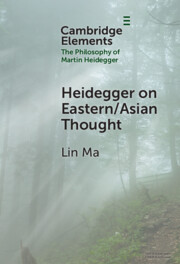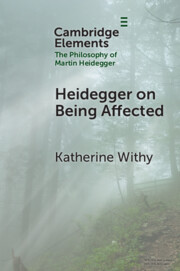93 results

Heidegger on Eastern/Asian Thought
-
- Published online:
- 24 May 2024
- Print publication:
- 30 June 2024
-
- Element
- Export citation

Heidegger on Being Affected
-
- Published online:
- 21 May 2024
- Print publication:
- 20 June 2024
-
- Element
- Export citation
Leader Authenticity and Ethics: A Heideggerian Perspective
-
- Journal:
- Business Ethics Quarterly , First View
- Published online by Cambridge University Press:
- 28 November 2023, pp. 1-20
-
- Article
- Export citation
6 - Heidegger and Sophocles
- from II - Heidegger and Greek Literature
-
-
- Book:
- Heidegger and Literary Studies
- Published online:
- 09 November 2023
- Print publication:
- 23 November 2023, pp 121-149
-
- Chapter
- Export citation
10 - Heidegger and Blanchot
- from III - Heidegger and Literary Works
-
-
- Book:
- Heidegger and Literary Studies
- Published online:
- 09 November 2023
- Print publication:
- 23 November 2023, pp 253-277
-
- Chapter
- Export citation
7 - Playing with Shadows in Heidegger’s Reading of Greek Tragedy
- from II - Heidegger and Greek Literature
-
-
- Book:
- Heidegger and Literary Studies
- Published online:
- 09 November 2023
- Print publication:
- 23 November 2023, pp 150-182
-
- Chapter
- Export citation
8 - Places of Pain
- from III - Heidegger and Literary Works
-
-
- Book:
- Heidegger and Literary Studies
- Published online:
- 09 November 2023
- Print publication:
- 23 November 2023, pp 185-213
-
- Chapter
- Export citation
4 - Technē: Creating Organizational Forms from the Earth
- from Part II - The Three Epochs of Strategy
-
- Book:
- The Poverty of Strategy
- Published online:
- 14 July 2023
- Print publication:
- 29 June 2023, pp 125-153
-
- Chapter
- Export citation
6 - Strategy as World Picture
- from Part II - The Three Epochs of Strategy
-
- Book:
- The Poverty of Strategy
- Published online:
- 14 July 2023
- Print publication:
- 29 June 2023, pp 182-202
-
- Chapter
- Export citation
5 - Technology, Machinery and Giving Over to the General in Strategic Practice
- from Part II - The Three Epochs of Strategy
-
- Book:
- The Poverty of Strategy
- Published online:
- 14 July 2023
- Print publication:
- 29 June 2023, pp 154-181
-
- Chapter
- Export citation
3 - Strategy in the Lifeworld, and the Problem with Home
- from Part I - Authenticity
-
- Book:
- The Poverty of Strategy
- Published online:
- 14 July 2023
- Print publication:
- 29 June 2023, pp 81-122
-
- Chapter
- Export citation
8 - ‘Subjugation, Execution, Then Devouring’
-
- Book:
- J. M. Coetzee and the Limits of the Novel
- Published online:
- 08 June 2023
- Print publication:
- 22 June 2023, pp 184-209
-
- Chapter
- Export citation
Conclusion
-
- Book:
- Heidegger's Interpretation of Kant
- Published online:
- 01 June 2023
- Print publication:
- 15 June 2023, pp 192-205
-
- Chapter
- Export citation
Chapter 2 - The Receptivity and Spontaneity of Cognition
-
- Book:
- Heidegger's Interpretation of Kant
- Published online:
- 01 June 2023
- Print publication:
- 15 June 2023, pp 40-72
-
- Chapter
- Export citation
Chapter 1 - The Two-Strand Method of Interpreting Kant
-
- Book:
- Heidegger's Interpretation of Kant
- Published online:
- 01 June 2023
- Print publication:
- 15 June 2023, pp 15-39
-
- Chapter
- Export citation
Introduction
-
- Book:
- Heidegger's Interpretation of Kant
- Published online:
- 01 June 2023
- Print publication:
- 15 June 2023, pp 1-14
-
- Chapter
- Export citation
Chapter 4 - The Metaphysical Deduction and Schematism
-
- Book:
- Heidegger's Interpretation of Kant
- Published online:
- 01 June 2023
- Print publication:
- 15 June 2023, pp 104-132
-
- Chapter
- Export citation
Chapter 3 - A Common Root
-
- Book:
- Heidegger's Interpretation of Kant
- Published online:
- 01 June 2023
- Print publication:
- 15 June 2023, pp 73-103
-
- Chapter
- Export citation
Chapter 17 - The Moral Eclipse of Boredom
- from Part III - Responses to Contemporary Moral Problems
-
-
- Book:
- Moral Education in the 21st Century
- Published online:
- 01 June 2023
- Print publication:
- 15 June 2023, pp 326-351
-
- Chapter
- Export citation
Chapter 6 - The Form of Time and Self-Affection
-
- Book:
- Heidegger's Interpretation of Kant
- Published online:
- 01 June 2023
- Print publication:
- 15 June 2023, pp 160-191
-
- Chapter
- Export citation



